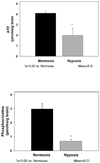Phosphorylation of caspase-9 in the cytosolic fraction of the cerebral cortex of newborn piglets following hypoxia
- PMID: 18840507
- PMCID: PMC2657363
- DOI: 10.1016/j.neulet.2008.09.076
Phosphorylation of caspase-9 in the cytosolic fraction of the cerebral cortex of newborn piglets following hypoxia
Abstract
We have previously shown that hypoxia leads to increased expression and increased activity of caspase-9 in the cerebral cortex of newborn piglets. Previous studies have demonstrated the importance of caspase-9 in the initiation of the apoptotic cascade, however, the mechanism of caspase-9 activation is not well understood. Experiments were conducted on newborn piglets 2-3 days of age that were anesthetized and mechanically ventilated. Hypoxia was induced by lowering the FiO(2) to 0.05-0.07 x 1h, and was confirmed biochemically by demonstrating decreased levels of ATP and PCr in the hypoxic groups in comparison with the normoxic group. The ATP level was 1.99+/-0.66 in the hypoxic group versus 4.10+/-0.19 in the normoxic group, P<0.05, and the PCr value was 0.68+/-0.14 in the hypoxic group, compared to 2.98+/-0.39 in the normoxic group, P<0.05. The cytosol of the neuronal nuclei from the cerebral cortex was probed with anti-phosphorylated Ser(196) caspase-9 antibody, using Western blot analysis. Protein bands were analyzed using image densitometry. In both the hypoxic and normoxic samples, protein bands were demonstrated just above the 50 kDa marker. Phosphorylated caspase-9 expression in OD x mm(2) was 43.85+/-8.4 in the normoxic group and 67.6+/-9.88 in the hypoxic group, P<0.05. The results of this study demonstrate that caspase-9, a key protein in hypoxia induced apoptosis, is phosphorylated at the Ser(196) site during hypoxia. The results demonstrate that hypoxia results in a post-translational modification of caspase-9 at Ser(196), which may alter the activity of caspase-9 in the hypoxic newborn brain.
Similar articles
-
ATP and cytochrome c-dependent activation of caspase-9 during hypoxia in the cerebral cortex of newborn piglets.Neurosci Lett. 2007 Dec 18;429(2-3):115-9. doi: 10.1016/j.neulet.2007.09.072. Epub 2007 Oct 11. Neurosci Lett. 2007. PMID: 17976908 Free PMC article.
-
Hypoxia-induced Bax and Bcl-2 protein expression, caspase-9 activation, DNA fragmentation, and lipid peroxidation in mitochondria of the cerebral cortex of newborn piglets: the role of nitric oxide.Neuroscience. 2006 Sep 1;141(3):1339-49. doi: 10.1016/j.neuroscience.2006.05.005. Epub 2006 Jun 13. Neuroscience. 2006. PMID: 16777344
-
Effect of hypoxia on the expression of procaspase-9 and procaspase-3 in neuronal nuclear, mitochondrial and cytosolic fractions of the cerebral cortex of newborn piglets.Neurosci Lett. 2008 Jun 13;438(1):38-41. doi: 10.1016/j.neulet.2008.03.078. Epub 2008 Mar 30. Neurosci Lett. 2008. PMID: 18468794
-
Mechanism of tyrosine phosphorylation of procaspase-9 and Apaf-1 in cytosolic fractions of the cerebral cortex of newborn piglets during hypoxia.Neurosci Lett. 2010 Aug 9;480(1):35-9. doi: 10.1016/j.neulet.2010.05.081. Epub 2010 Jun 4. Neurosci Lett. 2010. PMID: 20570712 Free PMC article.
-
Effect of neuronal nitric oxide synthase inhibition on caspase-9 activity during hypoxia in the cerebral cortex of newborn piglets.Neurosci Lett. 2006 Jun 19;401(1-2):81-5. doi: 10.1016/j.neulet.2006.02.070. Epub 2006 Mar 20. Neurosci Lett. 2006. PMID: 16545906
Cited by
-
Role of the ATM-checkpoint kinase 2 pathway in CDT-mediated apoptosis of gingival epithelial cells.PLoS One. 2010 Jul 23;5(7):e11714. doi: 10.1371/journal.pone.0011714. PLoS One. 2010. PMID: 20668524 Free PMC article.
-
Antioxidant and protective mechanisms against hypoxia and hypoglycaemia in cortical neurons in vitro.Int J Mol Sci. 2014 Feb 12;15(2):2475-93. doi: 10.3390/ijms15022475. Int J Mol Sci. 2014. PMID: 24526229 Free PMC article.
References
-
- Allan LA, Morrice N, Brady S, Magee G, Pathak S, Clarke PR. Inhibition of caspase-9 through phosphorylation at Thr 125 by ERK MAPK. Nat Cell Biol. 2003;5:647–654. - PubMed
-
- Cardone MH, Roy N, Stennicke HR, Salvesen GS, Franke TF, Stanbridge E, Frisch S, Reed JC. Regulation of cell death protease caspase-9 by phosphorylation. Science. 1998;282:1318–1321. - PubMed
-
- Cho SG, Choi EJ. Apoptotic signaling pathways: caspases and stress-activated protein kinases. J Biochem Mol Biol. 2002;35:24–27. - PubMed
-
- Delivoria-Papadopoulos M, Mishra OP. Mechanism of activation of caspase-9 and caspase-3 during hypoxia in the cerebral cortex of newborn piglets: the role of nuclear Ca2+ -influx. Neurochem Res. 2007;32:401–405. - PubMed
-
- Delivoria-Papadopoulos M, Mishra OP. Nuclear mechanisms of hypoxic cerebral injury in the newborn. Clin Perinatol. 2004;31:91–105. - PubMed
Publication types
MeSH terms
Substances
Grants and funding
LinkOut - more resources
Full Text Sources
Molecular Biology Databases




